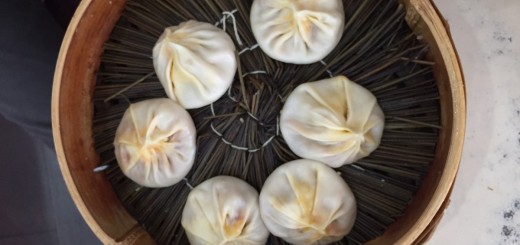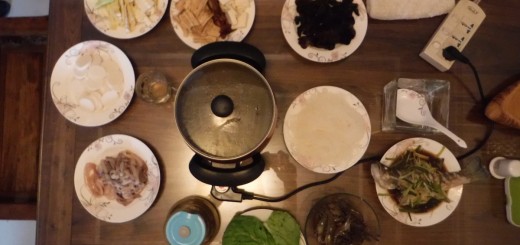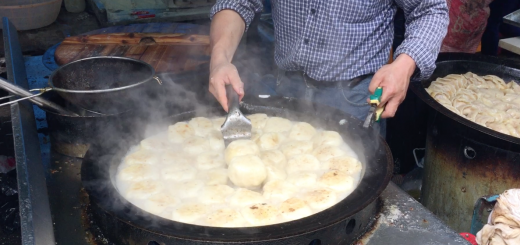Shandong Cuisine- Village of Zhengjianzhuang
Xiao Sun Guan Zhuang and Zheng Jia Zhuang are small south-eastern villages in Shandong province. We visited Ze’s family for about a week and stayed with various Aunt’s and Uncles. These are farm towns. Almost every family owns farmland where they grow peaches as a cash crop and vegetables, grains, potatoes and more to meet there own needs. Most families raise peanuts, which we often ate as a snack or a side dish. The peanuts are also pressed at a local shop into a rich aromatic oil that formed the flavor backbone of many of the dishes we had. Ze’s aunt and uncle have a special black variety of peanut that I’d never seen before. These have less oil in them with a crunchier texture and nuttier flavor, better for eating than pressing into oil. While in Beijing we tried a small dense fried donut called you guo. To my understanding it is made by mixing warm caramel with wheat flour and then frying pieces of this dough. When we ate you guo again in Shandong it tasted completely different, better, crunchier and nutier as if it had hazlenuts in it. It was actually just the local peanut frying oil that gave even this cheap, common treat it’s own local spin.
This village effortlessly creates its unique terroir because of its farming population. There are enough people growing peanuts for there to be a local peanut oil processor, enough people raising animals for there to be a local sausage maker that you just bring your own meat to, and mills in walking distance of every house to grind corn, wheat and dried sweet potatoes. It is rare that a place can produce most of its own food along with oil to cook it with. We talked about this oil often, considering the three of us had spent a quarter exploring the Terroir of the pacific northwest without even dreaming of locally grown and processed truly flavorful vegetable oil. We mostly use olive oil, canola oil or maybe grapeseed oil. I think only the canola is regional product but it still lacks character certainly isn’t grown in our backyards. Raw peanut oil they use is unlike any that we can get in the states, with its fragrant toasty, nutty and sweet smell that fills the room (or outdoor kitchen) and flavors the food, enhancing it’s terroir even further.
Locals here have multiple rooms and kitchens, all dedicated to food in different ways. There is usually an inside kitchen and a prep room for sitting and making time consuming things like dumpling and other bread products. There is just as much time spent cooking outside if not more than indoors. Everyone has an outdoor stove in their courtyard that they feed with local materials like cornhusks and stocks, tree bark from willow trees, and branches from dead or pruned peach trees. Ze’s relatives noted several times that cooking over the fire gives all their food a better flavor than cooking over a gas or an electric stove. I don’t think terroir is something these people are thinking about at all and I like how effortlessly it happens when they are producing their own food to sustain themselves. Because they raise plants and animals they are left with various other materials like oil, firewood, and manure that all enhance their local foods even more.
Eating with Ze’s family was an enlightening transition into old Chinese culture, traditions and manners. This village is very close to where Confucius was born and, while traditions are dying out in big cities and with younger generations, they continue rather strongly in Xiao Sun Guan Zhuan and Zheng Jia Zhuang. Food has a lot to do with culture here, it is an important part of their lives, livelihood, manners–a common greeting being “have you eaten yet?,” Sharing food, bringing presents of food, cooking and eating together are daily if not hourly occurrences of showing respect and thanks. Only when someone had told you they are full multiple times is it appropriate to stop gesturing them to eat. Before you start eating you are to invite everyone around you to share. All the food is served family style, no individual servings or plates. Everyone is sharing everything which gives the meal a tight sense of family and community. Compared to American culture it has a more communal enjoyment of things, fulfillment from sharing -not having. Being selfish or gluttonous is one of the rudest acts. If you have guests during a mealtime, you always feed them. If between meals, you still feed them a snack. This, although sometimes true in the U.S., is completely random, differing from family to family and person to person.
Due to us being guests and traveling far to visit them, Ze’s family made every meal a true feast. Most breakfasts, lunches, and dinners consisted of 6-10 or even more different plates or bowls stacked high with stir-fries, tofu, dumplings, salads, chicken, rooster, duck necks, soups, stews, deep fried things and a lot more. Our last dinner, hosted by Ze’s fifth uncle, counted 16 distinct dishes on the table. Ze’s families even slaughtered a goat to welcome our visit. We will write about the goat feast in a separate post.
We got to see the full process of making tofu from Ze’s cousin and his wife who make a local style of tofu. We walked in on him grinding the soaked soybeans into a white milkshakey slurry. Next they added boiling hot water they had been heating up over a coal fire in one of their two massive woks. The wife stirred the soy milk vigorously while the husband ladled in the boiling water. A thick white foam formed on top which the team skimmed off before straining the mixture through a cloth bag back into their large wok. They rewashed and strained the soybean solids a second time to get all the flavor and protein that they could. The leftover solids were fed to a healthy family of goats the couple kept in their courtyard. To strain the milk the husband and wife have a wooden bench that lays on top of the wok and holds the heavy bag up. The bench has a lever attached which they use to press and squeeze out as much soy milk as possible. The husband was scared to let us try because he said the bags were very hot which I would have never guessed by the way he was treating them and letting the water stream down his hands. Daniel did give it a try but gave up after a few seconds because the water was scalding hot. Turns out that the cousins hands had become use to very hot water in his past job of slaughtering pigs and scalding the skin to scrape off the hair. Slaughtering pigs at home for sale was made illegal by the government to help larger productions make more money. He now works as a construction worker, peach farmer, and a nightly tofu maker. They ladled us bowls of the hot soy milk which we drank next to the fire under the wok on a chilly night. It was slightly sour and kind of toasty tasting, Daniel describes it as nutty and rich with a very slight bitterness. While we drank, the couple continued their process, adding fermented soy whey from the previous nights batch. They stirred the huge wok and added more whey and continued like this for maybe forty minutes until the soy milk had separated into coarse fluffy curds and yellow, watery whey. Finally they scooped all the curds into a deep wooden box lined with cloth, which let all the whey drain back into the other wok. We got to have bowls of the curds and whey too, the curds were lightly funky from the musky, sour fermented whey addition with a nice tender/chewiness that was easy to eat even on a full belly at 11pm. This couple makes 70 pounds of tofu from 35 pounds of beans with this method. They told us this was a local flavor, a traditional way of making tofu in this area that younger generations are starting to appreciate less and less. With tofu being made on much larger scales with more mild flavors kids are starting to lean towards the less sour, funky, special flavor of this home-made tofu.
Pictures to follow!





